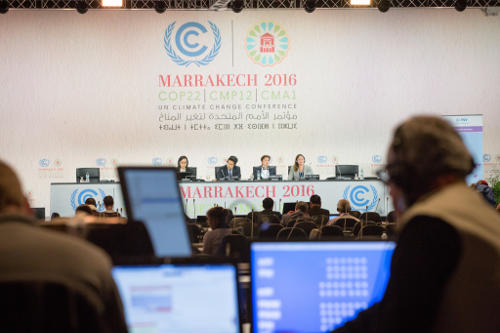Using AI to control energy for indoor agriculture
30 September 2024
Published online 17 November 2016
CO2 emissions stabilize worldwide, but keep rising in Arab countries.

Globally, CO2 emissions released in the atmosphere, equivalent to 36.3 billion tons in 2014 and 2015, are expected to rise by a mere 0.2% in 2016, in line with reports that the emissions' trend is flattening out now that the world's biggest emitters have reduced reliance on fossil fuel, specifically coal.
The data was released by the Global Carbon Project during the 22nd Conference of the Parties (COP22) in Marrakech.
Significantly, CO2 emissions of the world's leading polluter, China, have, over the past three years, come to a halt and started declining faster than expected. “The US is following the same trend as China following the drop in coal consumption,” says Glen Peters, senior researcher at the Center for International Climate and Environmental Research (CICERO). But, a lot of coal use has been replaced by larger consumption of oil and gas, he stresses.
With a few exceptions, this positive global trend is not followed by most Arab countries.
Many Arab nations are producing more carbon dioxide in 2015 despite an economic downturn triggered by plunging oil prices.
Low oil prices have only had a marginal impact on the level of emissions, especially in Saudi Arabia.
Saudi Arabia, the only Arab country included on a list of the top 10 biggest global CO2 emitters, has experienced a sharp rise between 2014 and 2015, growing from 575 million tons of CO2 to 601 MtCo2.
At 41tCO2, Qatar's per capita CO2 emission remains the largest worldwide, followed by Kuwait, the world’s fourth largest emitter and the region’s second, at 26tCO2 per capita.
Egypt, whose emissions are the second largest in the Middle East, is the largest polluter in Africa. Its emissions stand at 219 MtCO2, a rise of 2.1% between 2014 and 2015. Its capita CO2 emissions however, are 2.4tCO2 per person.
But these indicators do not necessarily reflect negligence.
Steve Griffiths, vice president for research at Masdar Institute in Abu Dhabi, UAE, explains that for Gulf countries, the main focus of their Nationally Determined Contributions (NDCs) under the Paris Agreement are based on economic diversification for lower greenhouse gases and CO2 emissions – a slow process. He is not surprised at the emission trends data, including increases for Saudi Arabia, UAE, Qatar, Kuwait, Oman, and Bahrain.
“Even in countries like the United Arab Emirates where renewables are gaining traction, we will not see impact on emissions until projects are built in the coming years and at a level with significant impacts on the power system profiles,” he says.
Low oil prices have only had a marginal impact on the level of emissions, especially in Saudi Arabia, the UAE and Qatar, because activity in key sectors in those countries has not fallen sharply.
“In fact, the peak load in electricity in Saudi Arabia was about 10% higher in 2015 than in 2014,” he says, adding that all Gulf Cooperation Council countries were able to weather the oil price downturn.
In northwest Africa, Morocco and Jordan's emissions remained stable since 2014, at 63MtCO2 and 26MtCO2 respectively, partly due to their strong commitment to renewable energy and subsidy reform programmes.
China’s significant dip in emissions brought the global emission level down. But the average level of carbon dioxide across the globe is still higher than 400 parts per million (ppm), which the World Meteorological Organization described as a “symbolic and worrying milestone.”
Even with aggressive efforts to curtail CO2 emissions, the concentration is unlikely to dip below the 400ppm mark for several decades; CO2 can last thousands of years.
“Land and ocean sinks can offset 50% of the emissions we take into our atmosphere, but the El Niño event of last year weakened the land sinks, which left higher concentrations of CO2 in the atmosphere,” explains Joeri Rogelj from the International Institute for Applied Systems based in Austria who contributed to the Global Carbon Budget assessment.
The Paris Agreement set out a target to reduce global emissions well below 2°C, with the ultimate aim of cutting the rise down to 1.5°C – a target that would require negative emissions, or the rapid shutting down of all fossil fuel infrastructure.
In order to achieve 2°C, 12 to 14 gigatons of greenhouse gases per year should be curtailed, says Jacqueline McGlade, the chief scientist and interim director of UNEP's Division of Early Warming and Assessment. One gigaton is equivalent to taking all the planes and cars out of Europe for one year.
If an aggressive global effort isn't undertaken to mitigate emissions, global temperatures will likely rise by 3.6°C according to the 2016 UNEP Emission Gap report.
doi:10.1038/nmiddleeast.2016.206
Stay connected: